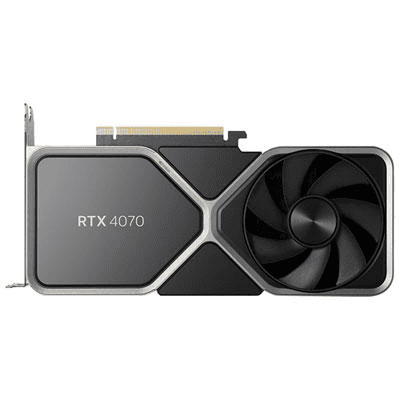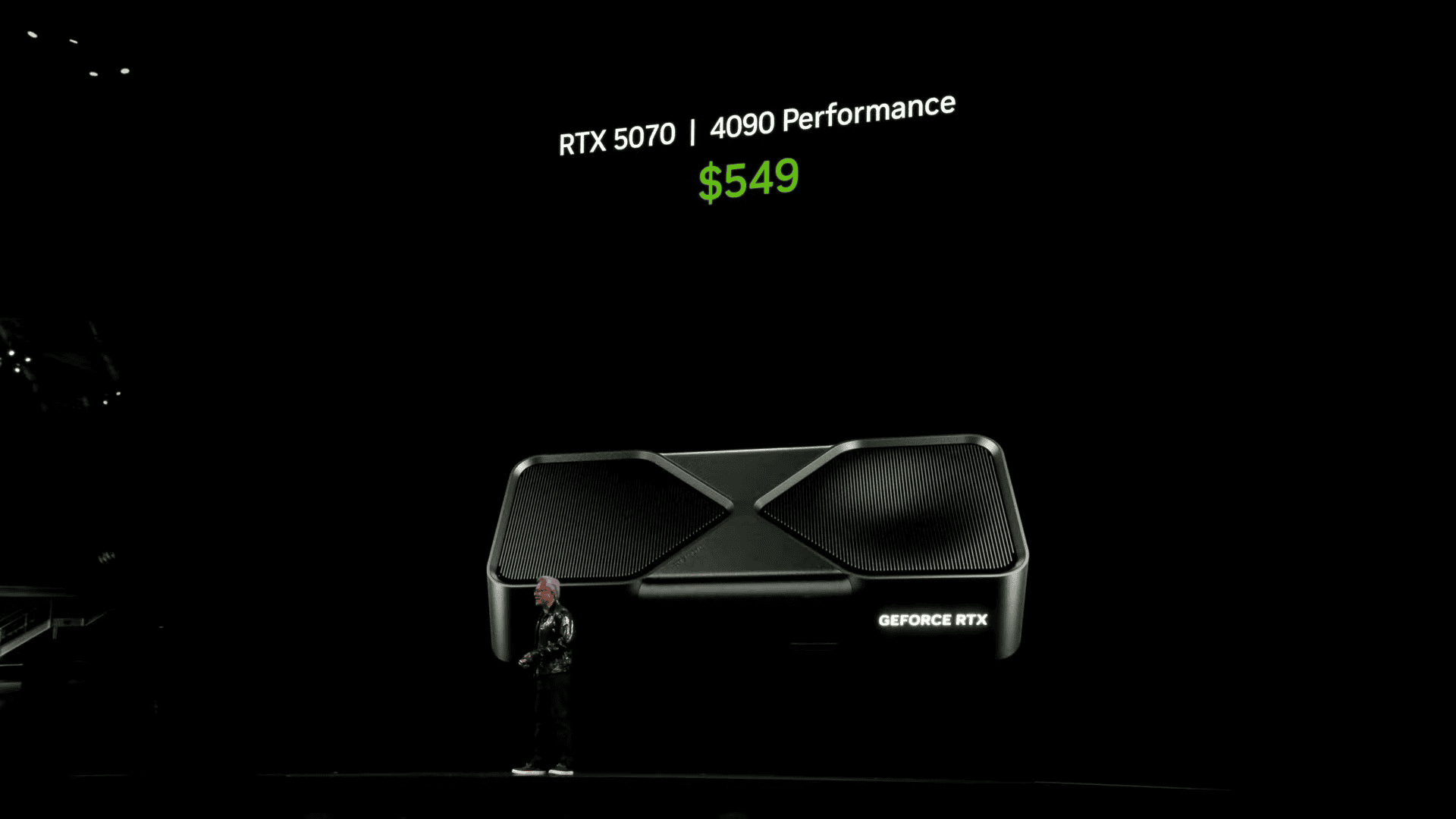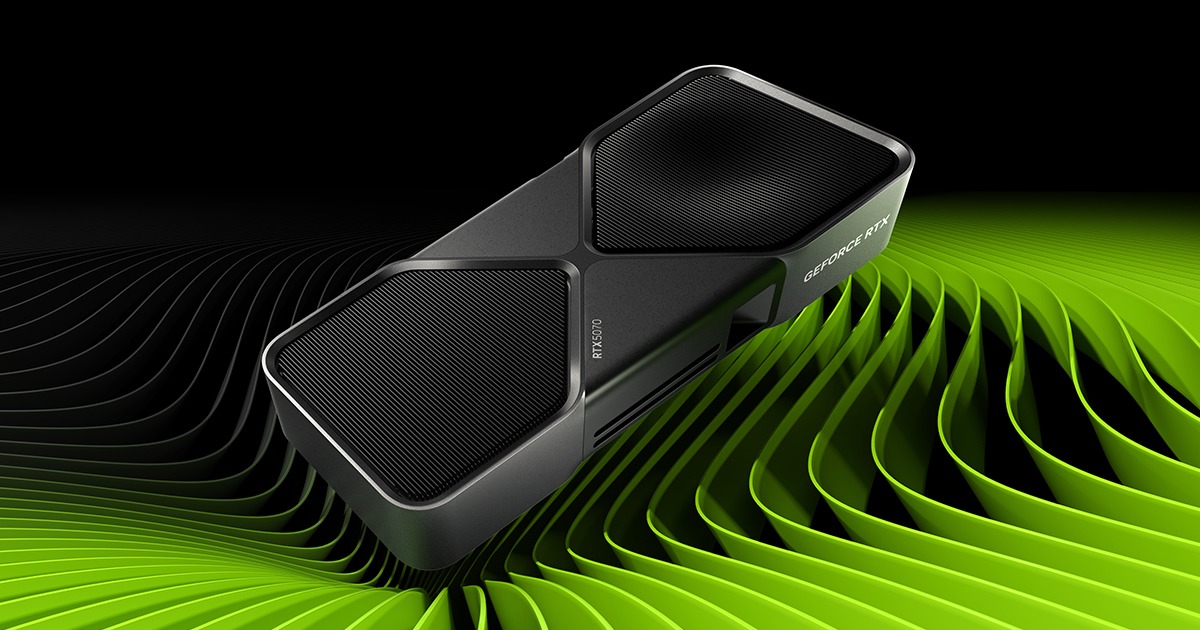The RTX 5070 promises a significant performance boost over its predecessor the RTX 4070. The RTX 5070 is expected to be released this February 2025 and will anchor the low to mid-range of Nvidia’s upcoming Blackwell GPU series. At a price of $549, it is set to deliver enhanced gaming and content creation capabilities at an amazing value (assuming you can get one at MSRP). Early estimates suggest a 30-40% increase in raw computing power for the RTX 5070 compared to the RTX 4070.
The RTX 5070 is expected to feature GDDR7 memory and approximately 7,500 CUDA cores. This hardware upgrade aims to improve 4K gaming performance and accelerate tasks like 3D rendering and video editing. The new GPU will likely support PCIe 5.0, offering improved data throughput and future-proofing for upcoming technologies.
Pricing details remain unconfirmed, but rumors suggest the RTX 5070 may offer better value than the current RTX 4070 Super. Gamers and content creators alike are eagerly anticipating the release of this next-generation graphics card, which could redefine performance expectations in its price range.
RTX 5070 vs. 4070: A Blackwell Showdown

Core Counts and Clock Speeds
The RTX 5070 boasts a significant increase in CUDA cores compared to its predecessor, the RTX 4070. With 6144 cores versus the 4070’s 5888, the 5070 promises a noticeable performance boost. Both cards feature Blackwell architecture, but the 5070 also has a slight edge in clock speeds, with a boost clock of 2.51 GHz compared to the 4070’s 2.4 GHz. This combination of increased core count and higher clock speeds should translate to smoother gameplay and faster rendering times.
Memory and Power Consumption
Both the RTX 5070 and 4070 come equipped with 12 GB of GDDR6 memory. However, the 5070 utilizes a 192-bit memory interface, while the 4070 has a 192-bit interface. This difference in memory bandwidth could potentially give the 5070 an advantage in memory-intensive tasks. In terms of power consumption, the 5070 has a TDP of 250W, slightly higher than the 4070’s 200W. This means the 5070 might require a slightly more robust power supply.

Features and Performance
Both cards support the latest technologies, including ray tracing, DLSS 4, and Reflex. However, the 5070’s architectural advancements and increased core count should result in a noticeable performance improvement over the 4070. Early benchmarks suggest the 5070 delivers a significant uplift in frame rates at both 1440p and 4K resolutions, especially in demanding games with ray tracing enabled.
Price and Value
The RTX 5070 is expected to be priced higher than the RTX 4070. While the official price hasn’t been announced yet, the 5070’s performance gains and feature set might justify the extra cost for gamers seeking the best possible experience. However, for those on a tighter budget, the RTX 4070 still offers excellent performance at a more affordable price point.
Comparison Table
| Feature | RTX 5070 | RTX 4070 |
|---|---|---|
| Architecture | Blackwell | Ada Lovelace |
| CUDA Cores | 6144 | 5888 |
| Boost Clock | 2.51 GHz | 2.4 GHz |
| Memory | 12 GB GDDR6 | 12 GB GDDR6 |
| Memory Interface | 192-bit | 192-bit |
| TDP | 250W | 200W |
| Price | Higher | Lower |
| Performance | Significantly better | Excellent |
Choosing the Right Card
Ultimately, the best choice between the RTX 5070 and RTX 4070 depends on your individual needs and budget. If you’re a gamer who demands the highest frame rates and visual fidelity, the RTX 5070 is the clear winner. However, if you’re looking for a more affordable option that still delivers great performance, the RTX 4070 remains a strong contender.
Beyond the 5070 and 4070: Exploring the RTX 50 Series Lineup
While the RTX 5070 and 4070 offer compelling options for gamers, the RTX 50 series has even more to offer. At the top of the line sits the RTX 5090, a powerhouse with 21760 CUDA cores and a massive 32 GB of GDDR7 memory. This card is designed for enthusiasts and professionals who demand the absolute best performance, capable of handling even the most demanding games and workloads with ease.
For those seeking a balance of performance and price, the RTX 5080 presents an attractive option. With 10752 CUDA cores and 16 GB of GDDR7 memory, it delivers impressive performance at a more accessible price point than the 5090.
Finally, the RTX 5070 Ti sits between the 5070 and 5080, offering a slight performance bump over the 5070 with 8960 CUDA cores and 16 GB of GDDR7 memory.
Key Takeaways
- The RTX 5070 is expected to offer 30-40% more computing power than the RTX 4070
- New features include GDDR7 memory and PCIe 5.0 support for improved performance
- The upcoming GPU aims to excel in 4K gaming and content creation tasks
Blackwell’s Innovation in GPU Technology
The release of NVIDIA’s RTX 50 series graphics cards has generated considerable excitement and anticipation among PC gamers and enthusiasts. With significant advancements in architecture, core counts, and memory technology, the RTX 50 series promises to redefine the gaming experience. In this article, we will focus on the RTX 5070 and its predecessor, the RTX 4070. We will compare their specifications, features, and potential performance to help you make an informed decision. Key differences between these two cards will be examined, including their core counts, clock speeds, memory configurations, and power consumption.
Additionally, we will explore the overall RTX 50 series lineup, highlighting the various options available to cater to different needs and budgets. Whether you’re a hardcore gamer seeking ultimate performance or a budget-conscious user looking for the best value, this guide will provide you with the insights needed to choose the right graphics card for your next PC build.
Nvidia’s Blackwell architecture introduces significant advancements in GPU technology. The new design promises improved performance and efficiency for consumer graphics cards.
Overview of Blackwell Architecture
Blackwell represents Nvidia’s latest GPU architecture. It builds upon the strengths of Ada Lovelace while introducing new features. The architecture focuses on enhancing ray tracing capabilities and AI performance.
Blackwell GPUs use a refined chip design. This allows for more transistors in a smaller area. The result is increased processing power and better energy efficiency.
The architecture also introduces improvements to Nvidia’s DLSS technology. This aims to deliver higher frame rates and sharper images in games.
Comparing Blackwell B200 to Prior Generations
The Blackwell B200 GPU shows notable improvements over its predecessors. It offers higher clock speeds and more CUDA cores than Ada Lovelace chips.
Blackwell GPUs feature enhanced ray tracing units. These provide faster and more realistic lighting effects in games. The new architecture also includes more tensor cores for AI tasks.
Memory bandwidth sees a significant boost in Blackwell. This allows for faster data processing and improved performance in memory-intensive applications.
| Feature | Blackwell B200 | Ada Lovelace AD102 |
|---|---|---|
| Process Node | TSMC 4NP | TSMC 4N |
| CUDA Cores | More (exact number TBA) | 18,432 |
| Memory Bandwidth | Higher | 1,008 GB/s |
Importance of TSMC 4NP and 3NM in RTX 50-Series
TSMC’s 4NP and 3nm processes play a crucial role in the RTX 50-Series GPUs. The 4NP process is an improved version of the 5nm node used in previous generations.
This new process allows for higher transistor density. It results in more efficient chips with lower power consumption. The 4NP node enables Nvidia to pack more features into the same chip area.
TSMC’s 3nm process is expected to be used in future Blackwell GPUs. This node promises even greater efficiency gains. It may allow for significant performance improvements in high-end consumer graphics cards.
The use of these advanced processes helps Nvidia maintain its competitive edge. It enables the company to deliver more powerful and efficient GPUs to consumers.
Analyzing Performance and Pricing
The RTX 5070 brings significant performance improvements over its predecessor, the RTX 4070. This new GPU offers enhanced memory configurations and bandwidth, potentially reshaping the price-to-performance landscape in the graphics card market.
Performance Benchmarks: RTX 5070 vs. RTX 4070
The RTX 5070 showcases a notable leap in performance compared to the RTX 4070. Preliminary data suggests the RTX 5070 delivers performance similar to the RTX 4090 when utilizing DLSS 4 technology. This represents a substantial generational improvement.
Specific performance metrics include:
- CUDA Cores: RTX 5070 is rumored to feature 7,500 CUDA cores, a significant increase from the RTX 4070’s 5,888 cores.
- TFLOPS: The RTX 5070 is expected to offer higher TFLOPS, translating to improved raw computational power.
In real-world gaming scenarios, the RTX 5070 is projected to outperform the RTX 4070 by 30% or more at the same price point. This performance boost is particularly noticeable in 4K gaming and content creation tasks like 3D rendering and video editing.
Memory Configurations and Bandwidth
The RTX 5070 introduces GDDR7 memory, a significant upgrade from the GDDR6X used in the RTX 4070. This new memory technology offers several advantages:
- Higher bandwidth: GDDR7 provides increased data transfer rates, enabling faster texture loading and smoother gameplay.
- Improved power efficiency: The new memory standard is expected to deliver better performance per watt.
Memory comparison:
| GPU | Memory Type | Memory Size |
|---|---|---|
| RTX 5070 | GDDR7 | 12GB (rumored) |
| RTX 4070 | GDDR6X | 12GB |
The RTX 5070’s memory configuration, coupled with its PCIe 5.0 interface, is likely to provide better data throughput. This enhancement makes the GPU more future-proof and capable of handling increasingly demanding games and applications.
Price-to-Performance Ratio and Market Impact
The RTX 5070’s pricing will play a crucial role in its market position. Early reports suggest a possible launch price of $599, matching the RTX 4070’s MSRP. If this holds true, the RTX 5070 would offer significantly better value.
Key pricing considerations:
- Performance increase: With a rumored 30% performance boost at the same price point, the RTX 5070 presents an attractive upgrade option.
- Market competition: The improved price-to-performance ratio may force competitors to adjust their pricing strategies.
The RTX 5070’s enhanced capabilities and competitive pricing could disrupt the mid-range GPU market. It may prompt current RTX 4070 owners to consider upgrading, while also attracting new buyers looking for high-performance GPUs at more accessible price points.
Frequently Asked Questions
The RTX 5070 and RTX 4070 differ in several key aspects. These differences impact performance, pricing, and features for gamers and content creators.
What are the specifications differences between the RTX 5070 and RTX 4070?
The RTX 5070 is expected to have 7,500 CUDA cores, a significant increase from the RTX 4070’s 5,888 cores. This boost in core count contributes to the RTX 5070’s improved performance.
The new GPU will likely feature GDDR7 memory, an upgrade from the GDDR6X used in the RTX 4070. This memory upgrade should enhance data transfer speeds and overall performance.
How does the price of the RTX 5070 compare to that of the RTX 4070?
Pricing details for the RTX 5070 have not been officially announced. The RTX 4070 launched with a suggested retail price of $599.
Industry analysts predict the RTX 5070 may have a similar or slightly higher price point at launch. This estimate is based on historical pricing trends for new GPU generations.
What improvements does the RTX 5070 offer over previous generations?
The RTX 5070 is expected to deliver a 30-40% increase in raw computing power compared to the RTX 4070. This performance boost stems from the new Blackwell architecture and increased CUDA core count.
The new GPU is likely to excel in 4K gaming and content creation tasks like 3D rendering and video editing. These improvements make it a strong option for users seeking high-end performance.
In terms of performance, how does the RTX 4070 stack up against its competitors?
The RTX 4070 is a capable mid-range GPU, offering excellent performance for 1440p gaming. It competes well with similarly priced options from AMD.
In benchmarks, the RTX 4070 often outperforms the AMD Radeon RX 6800 XT in ray tracing scenarios. However, the AMD card may have an edge in some traditional rasterization tasks.
What features distinct to the RTX Blackwell architecture enhance gaming experience?
The Blackwell architecture is expected to introduce improvements to NVIDIA’s DLSS technology. DLSS 4, if implemented, could offer even better AI-enhanced upscaling for smoother gameplay at higher resolutions.
Ray tracing performance is likely to see significant gains with the new architecture. This could lead to more realistic lighting and reflections in supported games.
What power efficiency advancements are included in the RTX 5070?
While specific power consumption figures are not yet available, NVIDIA typically aims to improve performance-per-watt with each new generation.
The move to a more advanced manufacturing process for the Blackwell architecture may contribute to better power efficiency. This could result in lower heat output and power requirements compared to the previous generation.






